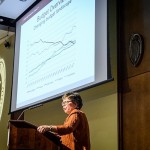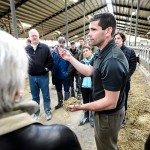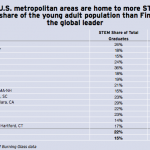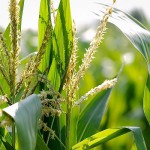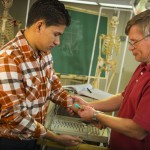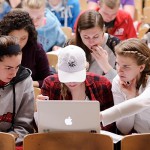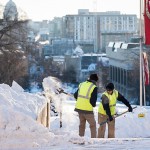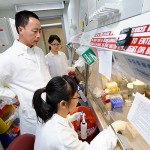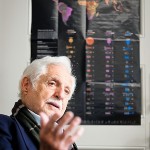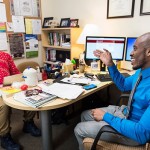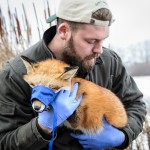Chancellor Blank discusses challenges of proposed budget cut at Board of Regents meeting
University of Wisconsin–Madison Chancellor Rebecca Blank told the UW Board of Regents that a proposed $300 million cut in state support for UW System would reduce student programming, lead to job lapses and layoffs, and reduce financial aid and access to the university.
Two UW–Madison engineers named to National Academy of Engineering
On Thursday, Feb. 5, the National Academy of Engineering (NAE) announced it has named two University of Wisconsin–Madison engineering professors to its 2015 class of new members. Grainger Professor of Power Electronics and Electrical Machines Thomas M. Jahns and Steenbock Professor of Engineering Physics Raymond J. Fonck are among the 67 new members and 12 foreign members elected to the NAE in 2015.
UW-Madison launches new website for flexible and online degrees and certificates
In an effort to highlight the University of Wisconsin–Madison’s growing menu of flexible and online degree and certificate programs, the campus is launching a new one-stop Web portal, advanceyourcareer.wisc.edu. The portal presents information about these offerings in one place, making it easier to learn about more than 40 online, hybrid, accelerated and evening/weekend programs. It also connects nontraditional students to special career services available for adult learners and community members.
Madison ranked top metropolitan area in U.S. for STEM graduates
The Brookings Institution on Tuesday recognized Madison, Wisconsin, as the number one metropolitan area in the U.S. for science, technology, engineering and mathematics (STEM) college graduates - the workers most likely to support the advanced industries that are driving the U.S. economy.
UW botanist harnesses the grid to illuminate crop growth
With help from the Center for High Throughput Computing (CHTC), botany Professor Edgar Spalding is applying this astronomical sense of scale to our understanding of corn. Spalding uses the HTC capabilities pioneered by Miron Livny, Morgridge Institute for Research chief technology officer, to quantify the incredibly complex process of corn growth from seed to vigorous seedling — not just one at a time, but over thousands of samples.
Innovative teaching practices encourage students in STEM
Like many seniors majoring in biology, Christian Hernandez is pursuing the pre-med track. However, he nearly didn’t make it past his freshman year at the University of Wisconsin–Madison As a Latino first-generation college student, Hernandez says he had no role models to help him achieve his career goal: to change the face of medicine in the United States. But then he took Physiology 335.
Recent sightings: Shoveling off Bascom
Hardworking grounds crew members shovel snow and clear the steps to the Lincoln Terrace near Bascom Hall during an early winter morning on Monday, Feb. 2. In the background on Bascom Hill hang banners featuring the university’s W crest.
Laying a foundation for treating ALS, spinal cord injury
Su-Chun Zhang, a professor of neuroscience and neurology at the University of Wisconsin–Madison Waisman Center, and his research team have published a unique model for learning more about the role of human astrocytes today in the Journal of Clinical Investigation today. The findings may lay a foundation for the treatment of a number of neurodegenerative diseases, including ALS (amyotrophic lateral sclerosis) and debilitating spinal cord injuries.
Student Employment: Now Hiring!
Campus and Visitor Relations is now hiring campus Tour Guides and Information Guides for summer 2015.
MEDIA ADVISORY: Forum on Growing Entrepreneurship in Wisconsin Feb. 5
MEDIA ADVISORY1/30/15TO: Media representativesFROM: Peter Kerwin, pkerwin@wisc.edu, 608-890-2045RE: FORUM ON GROWING ENTREPRENEURSHIP IN WISCONSIN FEB. 5
Recent sightings: Back-to-school advising
A whiteboard message of “Welcome back, scholars” is pictured on the door of advisor Quortne Hutchings’ office at the William S. Middleton Building…
Slideshow: Learning lessons by following Madison’s foxes and coyotes
Last year, a family of foxes — complete with roly-poly kits — took up residence on the University of Wisconsin–Madison campus and made the city its playground. With winter in full swing, the foxes and their larger dog-like counterparts, coyotes, are out there again, roaming the wilder (and often not so wild) parts of the city and campus. This year, David Drake, a UW–Madison associate professor of forest and wildlife ecology, is welcoming the public to join him and his research team as they go out and radio collar the animals in an effort to track and better understand these urban canids.
Learning lessons by following Madison’s foxes and coyotes
Last year, a family of foxes — complete with roly-poly kits — took up residence on the University of Wisconsin–Madison campus and made the city its playground. With winter in full swing, the foxes and their larger dog-like counterparts, coyotes, are out there again, roaming the wilder (and often not so wild) parts of the city and campus. This year, David Drake, a UW–Madison associate professor of forest and wildlife ecology, is welcoming the public to join him and his research team as they go out and radio collar the animals in an effort to track and better understand these urban canids.

